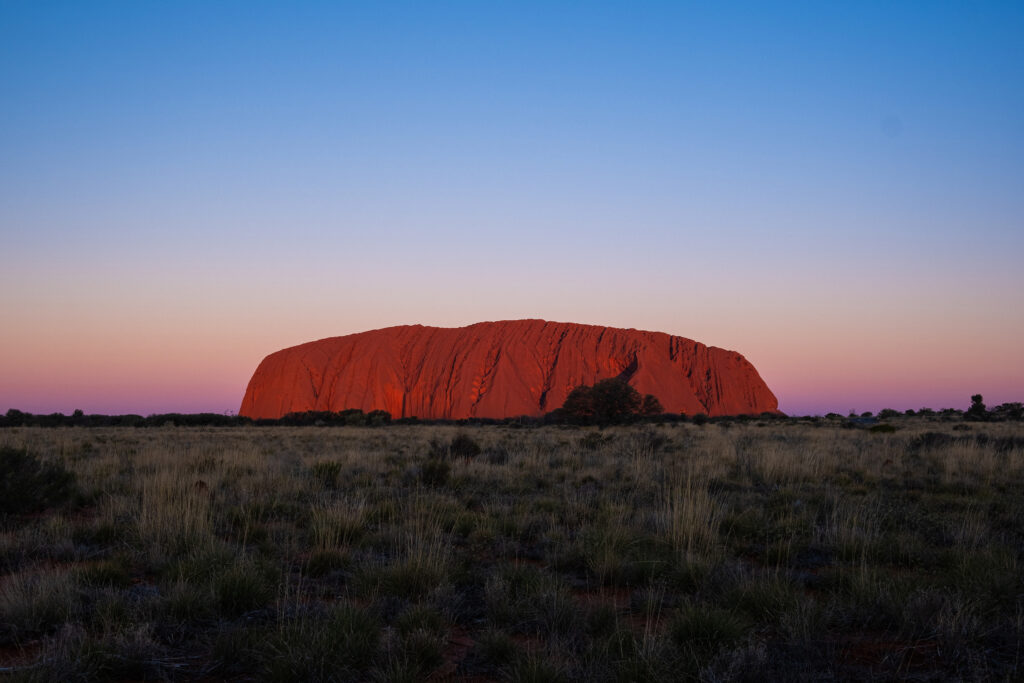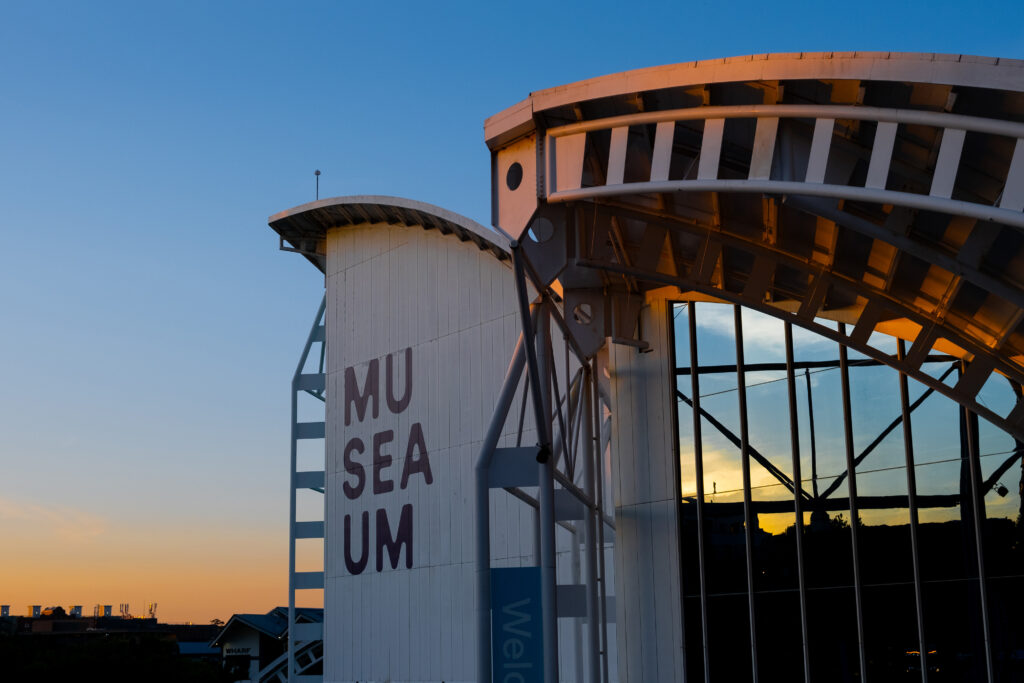A little thing about me: I never got to master swimming in the past twenty years of my life, but since I am now in Australia, I said to myself that I should not waste this natural beauty and the precious resources we have here down under. That is how I self-learned how to swim and obtained my Open Water Diver license in April this year. Since then, I have been enjoying scuba diving, especially at Shelly Beach, a small beach just next to the infamous Manly Beach. Just less than ten metres underwater, you get to see rays, sharks, and of course, our celebrity at Shelly – Basil the Green Turtle munching on seagrass.

Source: Dive Centre Manly.
It truly amazed me how we are so lucky to have such a beautiful aquatic reserve right next to the bustling city. However, this might not be the case – can you imagine having a Luna Park 2.0 in Manly? Yes, the definition of “leisure at Manly/Shelly” could be completely different as there were once proposals to completely revamp the scenery at Manly a century ago in the 1920s. Luckily thanks to the local community effort, not only were the plans terminated, but Cabbage Tree Bay also became a no-take aquatic reserve. That’s what my collaboration with Dive Centre Manly, a local dive centre that has been serving the Manly community at Belgrave Street since 1962, is about. I have created a website that serves as a central hub for the dive centre and Manly’s history, as well as studying the development of Cabbage Tree Bay from “one of the dirtiest spots in Manly” to almost an amusement park, and now an aquatic reserve.
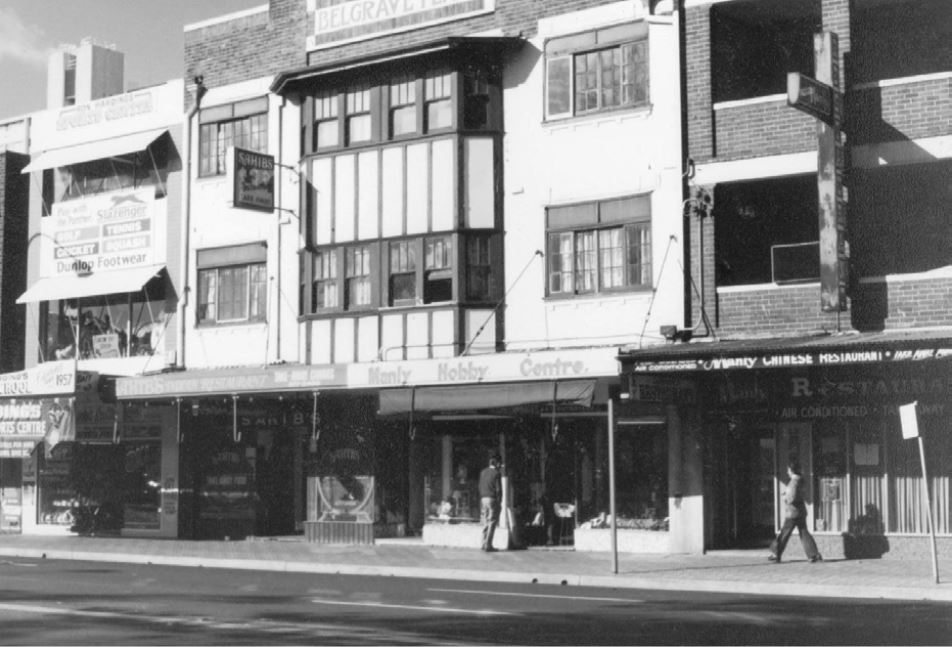
Source: Manly Library Local Studies.
With global climate issues such as extreme weather and ocean pollution such as the thunderstorms in Sydney and the mysterious black balls that washed up on Sydney beaches recently, both the daily lives of Sydneysiders and marine life are negatively affected. By promoting local conservation efforts like the regular Dive Against Debris event held by Dive Centre Manly, the organisation could gather more participants in beach and underwater cleanup. The project also assists the public in acknowledging their bargaining power and the significance of their contribution in negotiating and collaborating with resourceful governmental bureaucracies in making changes to their society.
I believe that the general public and community organisations, such as Dive Centre Manly, are some of the major, if not the most, contributors to the development of Cabbage Tree Bay from almost an amusement park to an aquatic reserve that has a richer biodiversity than most of the other aquatic reserves. From resistance such as protests, fighting funds and petitions to the municipal council in the 1920s to collaboration with governmental departments and publicly funded non-profit organisations in the late twentieth century until today, this project shows that community efforts in various aspects are effective in local marine conservation.
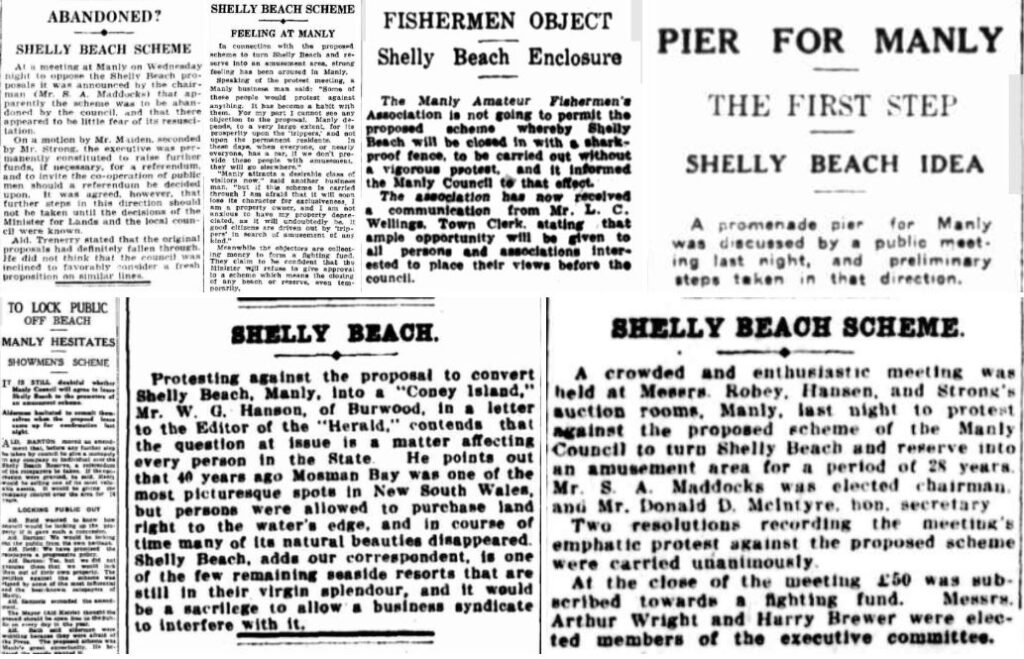
Source: Trove.
The project website is divided into four subpages, each with one theme: “Dive Centre Manly,” “Shelly Beach Amusement Plans in the 1920s,” “Cabbage Tree Aquatic Reserve,” and “Photo Album.” The 1920s page and the conservation page showed a contrast between how Shelly Beach could have become if the community had not contributed to striving for the area to become a no-take aquatic reserve, while the Dive Centre Manly page illustrated how the organisation has served the Manly community for over 60 years, as well as its continuing effort in preserving the natural beauty of Cabbage Tree Bay through adopting Manly Cove and Shelly Beach. The album provides visual comparisons for the aforementioned changes.
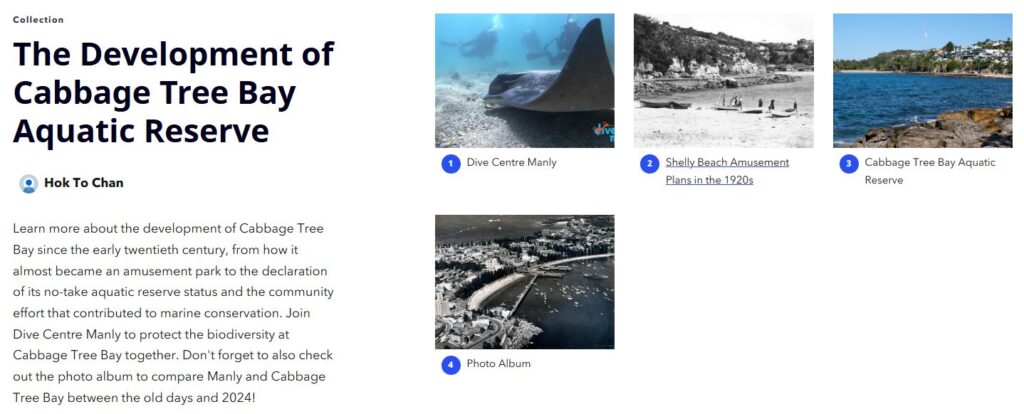
This project is innovative in bringing together history, social dynamics, urban development and marine conservation. Local residents and organisations as social agents constitute a large part of a community and therefore should never be underestimated in their contribution and involvement in writing history and development of their society. Also, responses from residents and visitors are focused on as they are the actual users of the aquatic reserve, presenting vastly different voices which are based on more personal experience, compared to government and council officials. Although the major focus is still on history, this project has the potential to develop into an interdisciplinary project with further collaboration with experts/students/stakeholders in various fields.
This project also provides a creative solution for different stakeholders in society to have a more holistic view of Cabbage Tree Bay. Resources available regarding the 1920s improvement plans were mostly if not all, written documents such as meeting minutes and local studies articles. This project draws from these records to produce a simulation/recreation of the proposed plans as an interactive map and references Coney Island in the US in assisting users to picture what the park might be like. Non-snorkellers and certified scuba divers also gain access to pictures and videos of local marine life – go check out Dive Centre Manly’s Instagram reel about Basil the Green Turtle!

My technique and focus on presenting all these information is mainly on visualisations. I have also included a lot of primary sources as the main evidence (and I do mean A LOT!). A large number of photos and videos are used. Maps, paintings and images of Cabbage Tree Bay since the late nineteenth century are compared with photos taken by me in early November to show the development of Manly. Illustrations of amusement facilities in places like Coney Island, Manly, and the Blue Mountains assisted in visualising the abandoned Shelly Beach Amusement Schemes. Sources such as photos and local studies stored at the Northern Beaches Library History Hub and the local history section on 2/F of Manly Library (shout out to the friendly and knowledgeable staff there!), especially the works by John Morcombe of Manly Daily, contributed a lot in supplementing and providing a concise introduction to the overall development. I have also personally visited Manly and took pictures with my camera for the comparison section on the photo album page to show the difference in the area over a century – I might not be a great photographer, but at least I think I get the locations right!
To supplement visuals with written records, council meeting minutes illustrate the discussion between investors and the council, and government gazettes, websites, reports and blogs are used to track the continuing conservation work done by the state government and the Northern Beaches council. For community efforts and perspectives of the public, newspaper articles, and letters to the editor are also included.
Of course, in the modern internet era, multimedia content such as photos and videos produced by Dive Centre Manly must not be missed. Please also spend some time watching the video on the Dive Against Debris event and listening to Richard Nicholls, the founder of Dive Centre Manly, about marine conservation at Shelly!
Oh and don’t worry about it being a plain website as I have prepared lots of interactive elements for you all: The interactive map on the 1920s page allows you to click on different sections to learn about the proposed amusements, while the slider photo album lets you compare certain spots of Manly and Cabbage Tree Bay at the same angle across a century (or more!) If you have time, hyperlinks to external websites and materials such as Government websites and content created by Dive Centre Manly for a deeper and more expertise understanding of marine conservation are also worth-visiting. Although the website has not yet been marketed, as Dive Centre Manly is active on Facebook and Instagram and holds weekly guided dives, trips, gatherings, and courses, the website could be promoted both in-person and online for a wider reach.

Note: This is a screen capture, so the slider function does not work here – visit the website!
The local community at Manly/Cabbage Tree Bay, visitors, and Dive Centre Manly will benefit from this project. By raising attention towards marine conservation, local residents and visitors (like us!), especially water sports lovers, can continue enjoying the natural beauty at Shelly Beach and Fairy Bower during weekend activities such as snorkelling, swimming, and diving and the biodiversity the reserve provides. Dive Centre Manly, although with a long history, did not have an archive for the record. This project serves as a central hub for the organisation and the community’s history, as well as educating the public about marine life and marine conservation at Cabbage Tree Bay.
The website will hopefully be continuously updated for the latest events held by Dive Centre Manly, as well as more photos and videos of the marine life underwater taken during these events (especially when season and daylight hours change there will be different creatures appearing). More information could also be supplemented in other aspects such as biodiversity, conservation and urban development through interdisciplinary collaboration. Interviews or feedback from different stakeholders such as local residents and participants of the community events could also be added to a new subpage of the website, acting like a discussion board/forum for information exchange and strengthening social unity. So feel free to tell us your story or experience!
Summer is coming, so whether you like visiting beaches just for a cup of coffee, going sunbathing, escaping the heat by jumping into the water, or going underwater for the fascinating scenery and experience swimming with the local marine residents, Shelly Beach is definitely your to-go destination! If you would like to join us in preserving this paradise, don’t forget to also check out and sign up for Dive Centre Manly’s regular Dive Against Debris event on their website – sign-up is free, gear rental is half-priced, and enjoy a barbeque together afterwards!
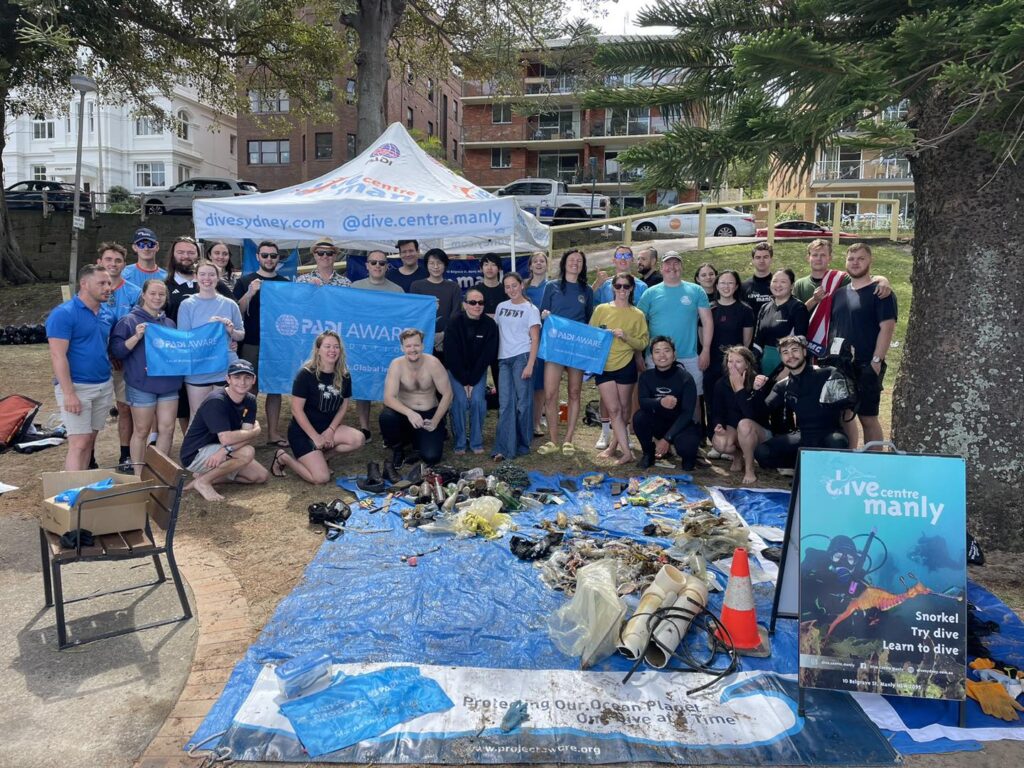
Although I am no longer working with the previous organisation as mentioned in my first blog post, I would like to quote myself again as this project still aims at spreading this message:
“It is the waters which shaped our nation, it is the people who lived through a diverse experience and explored the land and the ocean. By preserving and sharing the stories of people from different communities, I believe that the public interest and curiosity towards the relationships between us and the ocean can be sparked…”
This semester, particularly my time in this unit, has been fruitful and fun – perhaps the best unit I have ever taken at uni. I would also like to take this opportunity to thank James and Mike for allowing us to temporarily get out of the classrooms and libraries and into the society we’re living in. The semester has ended, and it’s goodbye for now, but I hope to see you guys again no matter at Manly or in the public history field!


